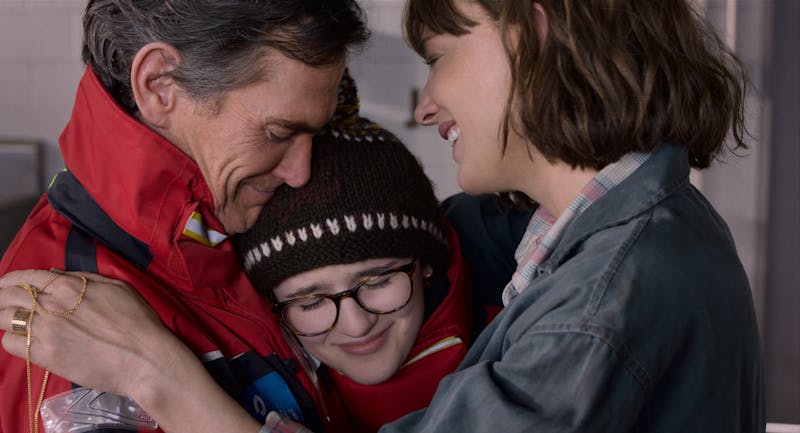Maria Semple’s Where’d You Go, Bernadette is not the greatest book ever written, but it is so much better than the new movie adaptation by Richard Linklater that it warrants defense. Do not be fooled by its beach-read “chick-lit” cover design, featuring a cartoon of the title character in big Jackie O sunglasses, because Where’d You Go, Bernadette is something much more complicated: It’s a mystery thriller about a middle-aged woman—an artistic genius battling a trauma-laden marriage—as related through a satirical epistolary novel about suburban Seattle life, partially narrated by her 15-year-old daughter. Where’d You Go, Bernadette is a serious book disguised as a trifle.
The passages by the daughter, Bee (short for Balakrishna), are interspersed between bits of “found text”: emails fly between moms from Bee’s school who hate her mother for being snooty; Bernadette writes loopy messages to a Siri-like virtual assistant named Manjula; forensic reports from ships at sea chart mysterious events. As the title implies, Bernadette disappears, apparently because of a psychic break brought on by the stress of agreeing to take Bee on holiday to Antarctica. A series of misunderstandings builds up between Bernadette and the Seattleites around her, and between her and Elgie, her husband—a brilliant but rather milksop-ish celebrity Microsoft engineer—who contemplates having his beleaguered wife committed to a psychiatric hospital.
Bee is a prodigious wise-ass. Having endured a tough infancy dotted by heart surgeries, she’s grown up into the kind of ninth grader who is ravenous for more knowledge, more insight, more life. Because of Bee’s intelligent mind and spirit, we trust her to tell us who her mother is, and to helm her story. Through a rather clumsy “Artforum profile” we learn that Bernadette is—like Bee—a genius. She was the most promising architect of her generation but ran off to become a recluse in Seattle after the building that won her a MacArthur Grant—yes, she has a MacArthur—was destroyed by a vengeful neighbor. Several miscarriages and Bee’s harrowing birth followed, trapping her career under a big pile of failure and grief, out from which she cannot get.
The book’s satire is trained on the awfulness of affluent tech society, which turns out to be Bernadette’s Achilles’ heel. (What if Manjula isn’t who she says she is? The virtual assistant turns out to be an important symbol and narrative pivot, tipping the plot into action.) But at the heart of the book is a character portrait. Bernadette emerges piecemeal (an itemized hospital bill can say a lot), building a lot of tension until the book explodes into a full-on missing-persons case. Vital to this portrait are contemporary architects’ recollections of Bernadette in her youth. She achieved two great works before quitting, both based on the principle of recycling and the handmade. First, she turned an old bifocal factory inside out, knitting old glasses frames into a chain-mail exterior and flooding the interior with intimate design. Next, she built Twenty Mile House, a pavilion-style home in Los Angeles composed entirely of materials recovered or manufactured within a 20-mile radius of the site.
That humane architectural ethic provides the urgency behind Bernadette’s decision to go off the reservation—it makes the case that this woman must not be allowed to lose her mind, even if the cost is that she must disappear from her child’s life.

Imagine you’re a big-shot Hollywood executive, and somebody has handed you the above book report. How would you make it into a movie? It’s an odd choice for adaptation at all, because you (the executive) will have to find a way to blend social comedy, whodunit, feminist art critique, and maternal trauma into one coherent blockbuster. You’d have to find somebody really brilliant to do the script, and then find somebody even more brilliant to act it.
Fortunately, Richard Linklater hired Cate Blanchett to play Bernadette. Unfortunately, he has declined to make either a comedy or a thriller or an art movie or anything coherent at all, instead relying on Blanchett to carry the movie on her performance alone. The script is an insult to the principle of adaptation: All that is good in the plot has been excised in favor of the shortest route to a happy ending.
For example, the social satire aspect of the novel comes to a glorious climax in the book when a mudslide explodes into a neighbor’s house during a school fundraising brunch. The scene is violent and symbolic and it connects to multiple themes: the grinding monotony of Seattle’s unrelenting rain echoes Bernadette’s domestic imprisonment, while the slipping foundations of her property tell us something about the stability of her own mind. We read about the mudslide through a detailed report written by the school’s authorities, as they provide a full and honest account of events to the parents and recommend best practices for avoiding PTSD.
In the movie, by contrast, there’s a brief ripple of mud, then Bernadette cries.
It’s barely worth mentioning Billy Crudup as Elgie—his character has been gutted. Linklater has declined to make Bernadette’s husband into a villain, turning him into a beaming, moronic footman when his character requires abusive tendencies. Even worse, the mystery is all gone. Instead of Bernadette disappearing, we watch her every movement while, in parallel, seeing Bee and Elgie freak out. Bee gets to do zero detective work, and anyway her character is never developed. The Artforum profile turns into a poorly-produced bit of web content scored by awful, chirpy music.
Blanchett is, as ever, astonishing. As the deluded Bernadette, she exudes a self-hating theatricality that strongly recalls her role in Blue Jasmine—a woman trying to convince herself of an identity she cannot believe in. Every scene without her in it is a bust. It almost makes sense: Linklater et al. stripped everything away from the book that did not directly concern Bernadette, so that Blanchett could shine. But she cannot even become an artist, here: Her house is decorated with little designs made out of paper fans and pencils, like a tacky Pinterest board.
Blanchett gives it her all, and if Bernadette exists anywhere it is in the way the actor holds her body, a surge of love for her child expressed in the angle of her torso.
As if in a perfect encapsulation of this whole catastrophe, the title of the movie is missing the question mark. Where’d You Go, Bernadette?, a snappy, going-somewhere title, has become Where’d You Go, Bernadette, which is a robotic statement. This movie will leave you with no questions whatsoever, besides what kind of consequences face a production team that allows a project to be so savaged—by whatever powers, god knows their motivations—as to blot the resume of not one, but two contemporary women powerhouses of the arts. Neither Cate Blanchett nor Maria Semple deserve what happened here. As Bernadette teaches, women should hold their identities close and their art even closer: You never know who’s going to come along and tear it all down.
